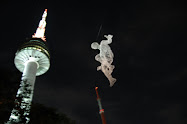
Seoul is the epicenter of all culture Korean. The people of South Korea need fed and watered and they go to Seoul for the best their country offers. They demand satisfaction in bars, shopping, and restaurants. And their needs are met. On the weekends traffic stacks back kilometers before the city limits even begin. The culturally rich city calls in the crowds.
Looking out from the Seoul Tower in the daytime, the city maps out like most of the major cities we see in our lives. Landmark buildings, a downtown district, and a river runs through it. But look closer. There are worse evils than tract housing. This city sprawls away from the downtown skyscrapers into districts and housing like other cities. Yet where others might spread out into housing developments Seoul stands tall. In place of gated communities colonies of high-rise apartment buildings stretch on forever, out beyond the city limits.
Along the Han River, like many Korean rivers, white herons stand in sandbars. Legions of orange dragonflies hunt mosquitoes—-flying, diving through the grass, hovering like helicopters. The surrounding mountains are green, verdurous, and at their foothills rice grows knee-high. Eventually, we turn and look to the north but we can’t see very far. Gray fog veils the border, where beyond a country skulks condemned for its secrecy and suppression.
At night, red crosses burn among the apartment lights. They float in the darkness—-a gang of kinsfolk with raised fire marching to torch a house of heathens. They seem to always face you, with more behind them in the distance and on the horizon, the Lord’s cavalry. These red neon crosses raised my first question when I came to Seoul nine months ago. I soon found out they signified Christian churches and sit at the top of steeples, lighting the way for wayward sinners, driving out the dark.
Scanning the nighttime city from the banks of the Han, neon grids trace building edges in pink, green, and blue. Low clouds obscure the tip of the Seoul Tower and the cyclopean light glows white gray. Around it clouds drift and swirl then suddenly the red and white spire succumbs to the Korean Neon. It climbs the tower flashing purple and green and the panoramic restaurant halfway up switches on into a spinning carousel of circus lights. Below it on the edge of the river we watch the lights on the bridges slow-fade change in the colors of the rainbow. The murky water turns royal blue, then blood red, and the current carries on.
Friends call from a bar in Itaewon, the district near the American military base. Walking up the hill we pass two boys, not older than 20, shuffling back to base. “You have to remember to cherish every day,” one says, dead serious, looking at the sidewalk. They disappear. At the top of the hill our friends are out in the street in a crowd of foreigners. Through the windows of a bar a crew-cut boy dances shirtless with another boy. People yell and jump and break glass. Everyone’s trying to live a life in one night.
A missionary for an organization called Kingdom Builders hands me a flyer with Bible verses and a paragraph that reads: “As you take this paper tonight, stop and look around you. How many people are running into places that lead to destruction?”
We drive out of there, tuning into the base radio station and it’s American Country Countdown, counting down America’s greatest hits. We listen to the strange canned country music and public service announcements with hotline numbers for victims of sexual assault. The shirtless boy runs through the sidewalk crowd back down the hill, racing against his curfew. It is late but the city will stay up. Those tired of bars will find street-vendors or karaoke rooms or love motels. All around us, keeping out the dark and the stars, the buildings glow on, bright neon and vivid.





